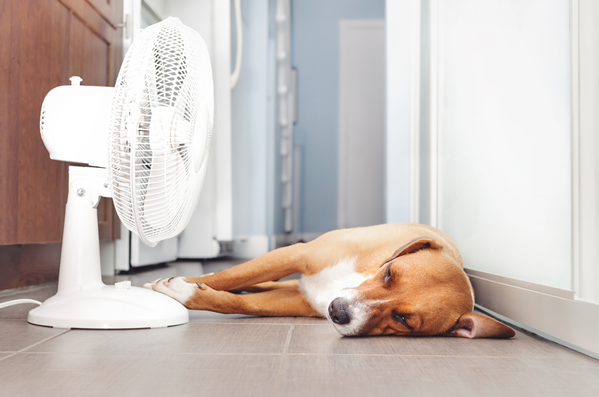
As the summer heat intensifies, it’s important to remember that our furry friends are also susceptible to the dangers of high temperatures. One of the most serious risks pets face during hot weather is heat stroke.
How Pets Can Get Heat Stroke
Heat stroke occurs when a pet’s body temperature rises to a dangerous level, and they are unable to cool down. Here are some common scenarios that can lead to heat stroke in pets:
- Hot weather: Simply being outside in hot weather, especially during peak sun hours, can cause a pet to overheat.
- Lack of shade and water: Pets left without adequate shade and fresh water are at a higher risk of overheating.
- Exercise: Vigorous exercise in hot weather can quickly lead to heat exhaustion and heat stroke.
- Hot cars: Leaving a pet in a parked car, even for a few minutes, can be extremely dangerous because temperatures can quickly rise to lethal levels.
- Breed predisposition: Certain breeds, particularly those with short snouts like Bulldogs and Pugs, are more prone to heat stroke due to their less efficient cooling mechanisms.
What Heat Stroke Can Cause
Heat stroke can have severe consequences for pets, including:
- Dehydration
- Organ failure
- Brain damage
- Death
High body temperature can cause irreversible damage to a pet’s internal organs and, if not treated promptly, can be fatal.
Recognizing the Signs of Heat Stroke
Knowing the signs of heat stroke in pets is crucial for early intervention. Common symptoms include:
- Excessive panting: While panting is normal, excessive, and prolonged panting, especially when combined with drooling, can indicate heat stroke.
- Lethargy and weakness: If your pet seems unusually tired, weak, or uncoordinated, it could be a sign of overheating.
- Vomiting and diarrhea: Heat stroke can cause gastrointestinal upset, leading to vomiting and diarrhea.
- Bright red or pale gums: Changes in gum color, either bright red or very pale, can indicate heat stroke.
- Rapid heart rate: An elevated heart rate is another sign that your pet may be suffering from heat stroke.
- Drooling: Excessive drooling, especially thick or sticky saliva, is a common sign of heat stroke.
- Collapse or seizures: In severe cases, pets may collapse, have seizures, or even become unconscious.
What to Do If Your Pet Has Heat Stroke
Immediate action is essential if you suspect your pet is suffering from heat stroke. Here’s what you should do:
- Move to a cool area: Get your pet out of the heat and into a cool, shaded area or an air-conditioned room as quickly as possible.
- Offer water: Provide small amounts of cool (not cold) water to help lower their body temperature. Avoid letting them drink too much, too quickly.
- Cool down your pet: Use cool (not cold) water to gently wet your pet’s fur, especially on the belly, paw pads, and around the ears. You can also place cool, wet towels on these areas. Avoid using ice or extremely cold water as this can cause blood vessels to constrict, making it harder for the body to cool down.
- Use a fan: If possible, use a fan to help cool your pet down. This can speed up the process of lowering their body temperature.
- Monitor temperature: If you have a rectal thermometer, check your pet’s temperature. Normal body temperature for dogs and cats is between 101°F and 102.5°F (38°C-39.2°C). If their temperature is above 104°F (40°C), they are in danger.
- Seek veterinary care: Even if your pet seems to recover, it’s essential to take them to the vet as soon as possible. Heat stroke can cause internal damage that might not be immediately apparent.
Preventing Heat Stroke in Pets
Preventing heat stroke is far better than treating it. Here are some tips to keep your pet safe in hot weather:
- Provide shade and water: Ensure your pet always has access to plenty of fresh water and a shady spot to rest when outdoors.
- Avoid midday heat: Exercise your pet during the cooler parts of the day, such as early morning or late evening, to avoid the hottest temperatures.
- Never leave pets in cars: Never leave your pet in a parked car, even with the windows cracked. The temperature inside a car can rise to dangerous levels in minutes.
- Be mindful of breed: If you have a breed that is more prone to heat stroke, take extra precautions to keep them cool.
- Use cooling products: Consider using cooling mats, vests, or bandanas designed to help keep pets cool.
- Monitor your pet: Keep a close eye on your pet during hot weather and be alert for any signs of overheating.
Heat stroke is a serious and potentially fatal condition that can affect pets during hot weather. By understanding the signs of heat stroke, taking prompt action, and following preventive measures, you can help ensure your furry friends stay safe and healthy all summer long. Stay cool, and keep your pets cool, too!
